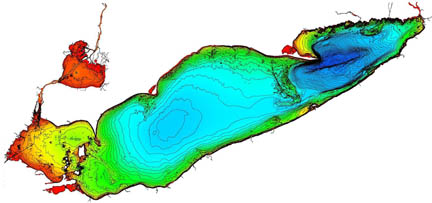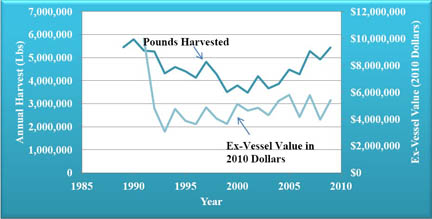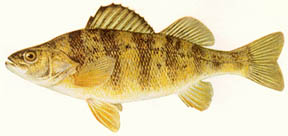Lake Erie - the E in HOMES
The acronym HOMES helps us remember the names of the five Great Lakes. This article focuses on the E in HOMES—Lake Erie.
Lake Michigan - the M in HOMES
Lake Superior - the S in HOMES
Lake Erie is the 11th largest freshwater lake in the world, with a surface area of 9,910 square miles and a shoreline of 871 miles. It is the fourth largest among the Great Lakes by surface area and the smallest of the Great Lakes by volume (116 cubic miles). Due to its comparatively small volume, it also has the shortest retention time – 2.7 years. Lake Erie is the shallowest, with a maximum depth of 210 feet, and because of its shallow depth, Lake Erie is the only Great Lake with its entire bottom above sea level. 
Morphologically, Lake Erie can be considered three lakes, with a shallow western basin, a deep eastern basin, and a central basin of moderate depth. These three Lake Erie basins exhibit differences beyond simply depth. They each have characteristic levels of biological productivity, fish populations and temperature profiles. The central basin is also the only one that exhibits “dead zones” where dissolved oxygen levels are zero (anoxic) or very low (hypoxic).
Four states – Michigan, Ohio, Pennsylvania and New York – and the Canadian province of Ontario border on Lake Erie. Surprising to many, Lake Erie was the last of the Great Lakes to be discovered by European explorers, but its basin has grown to become the most densely populated of all, and the large metropolitan areas of Detroit, Toledo, Cleveland and Buffalo are located within the Lake Erie basin. The Lake Erie basin supports a varied economy with strong industrial, agricultural and recreational sectors. One of the largest sandstone mines in the world is in Ohio, large salt mines are located on the south shore of Lake Er ie, and significant natural gas reserves are located under the lake.
ie, and significant natural gas reserves are located under the lake.
Lake Erie’s commercial fishery is as productive as the fisheries of the other four Great Lakes combined, having produced an annual average harvest of 4.8 million pounds over the 2005-2009 period valued at more than $5 million, according to the 2012 Great Lakes and Mississippi River Interbasin Study. The Lake Erie walleye fishery is widely seen as the best in the world, and yellow perch – often cited as the favorite food fish of the Great Lakes – are abundant as well. Walleye and perch, combined, account for more than 54 percent of the total Lake Erie commercial harvest and more than 80 percent of its total value. Lake Erie is also the most popular of the Great Lakes with recreational anglers. In Ohio alone, sport anglers made over 550,000 trips to fish Lake Erie in 2011, with private sport fishing effort topping 2.67 million hours. Walleye and perch were the target species for more than 94 percent of these anglers according to the Ohio DNR.
The Lake Erie basin has the largest percentage of land in agriculture production in the Great Lakes. Agriculture dominates the economy of the western and northern shores of the lake. Lake Erie waters help to moderate coastal temperatures, making the growing season there last up to three weeks longer than farther inland, benefitting fruit farms, nurseries and vineyards along the coast.
Lake Erie is the most nutrient-rich and warmest of the Great Lakes and is, therefore, the most biologically productive. The abundance of nutrients also makes Lake Erie the most prone to harmful algal blooms.
Its coastal wetlands thrive in this climate and contain the greatest diversity of plant and animal species in the Great Lakes. The lake and its marshes are home to more than 100 species of fish and 300 species of birds.
Michigan State University Extension and Michigan Sea Grant offer many educational programs to those along Michigan’s portion of the Lake Erie shore. We also collaborate with other state Extension programs and regional groups that border Lake Erie, such as the Great Lakes Sea Grant Network, the Great Lakes Observing System, COSEE Great Lakes, the Great Lakes Restoration Initiative, and the Great Lakes Stewardship Initiative, providing additional opportunities to include Lake Erie and those who live in its basin as participants in the Great Lakes Literacy Initiative.
This article was adapted from MSU Extension Bulletin E-1869 (October 2000) – Lake Erie Basin.



 Print
Print Email
Email




